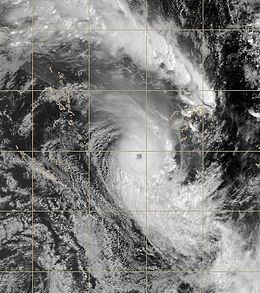Fatalities None reported | ||
 | ||
Formed January 15, 2008 (2008-01-15) Dissipated January 21, 2008 (2008-01-22) Highest winds 10-minute sustained: 175 km/h (110 mph)1-minute sustained: 195 km/h (120 mph) Lowest pressure 930 hPa (mbar); 27.46 inHg Date 15 January 2008 – 21 January 2008 Similar Cyclone Sose, Cyclone Tia, Cyclone Trina, Cyclone Esau, Cyclone Paula | ||
Severe Tropical Cyclone Funa (RSMC Nadi designation: 10F, JTWC designation: 12P) was the strongest tropical cyclone during the 2007–08 South Pacific cyclone season, causing heavy flood and wind damage to areas of Vanuatu. The third tropical cyclone and second severe tropical cyclone of the season to form to the west of 160°E, Funa formed from an area of disturbed weather within the monsoon trough northeast of Vanuatu on January 16, 2008. Steadily intensifying as it moved to the east and subsequently south, Funa reached peak intensity with winds of 175 km/h (110 mph), sustained for ten minutes. However, the cyclone encountered unfavorable conditions as it progressed further south, before transitioning into an extratropical cyclone on January 21.
Contents
Cyclone Funa severely affected areas of Vanuatu, especially to the island chain's infrastructure. Regions of the coast were also inundated by sea flooding caused by strong storm surge associated with Funa. Offshore, the cruise ship Pacific Star sustained heavy damage from the cyclone's strong waves. The cyclone's remnants later caused strong winds in New Zealand, resulting in power outages and fires.
Meteorological history
On February 15 the Regional Specialized Meteorological Center in Nadi, Fiji (RSMC Nadi) and the Joint Typhoon Warning Center (JTWC), reported that a tropical depression had developed within an monsoon trough, about 700 km (435 mi) to the northeast of Port Vila on the Vanuatuan island of Efate. During that day the depression moved eastwards and gradually developed further, before as vertical windshear slackened a little, the JTWC and RSMC Nadi reported that the depression had developed into a tropical cyclone with the later naming it as Funa at 0600 UTC on February 16.
The cyclone then started to move eastwards and passed near the northern tip of Aurora Island, Vanuatu with wind speeds of 55 knots (102 km/h), making Funa a category two cyclone on the Australian scale. After leaving Vanuatu, Funa intensified slowly becoming a Category 3 severe Tropical cyclone on January 18 and then early the next day it reached its peak wind speeds of 95 knots (176 km/h) which is the same as a category 4 cyclone according to the Southern Pacific Cyclone Scale. The JTWC measured Funa's peak winds at 105 knots (194 km/h). The storm then moved into TCWC Wellington area of responsibility it started to weaken and then became extra tropical the next day with the JTWC issuing their final advisory on January 20, with TCWC Wellington downgrading it to a low later that day.
Preparations and impact
Severe damage occurred over the groups of islands in the Torba, Sanma, and Penama provinces of Vanuatu, particularly on dwellings (made of local material), trees, and crops. Over the Banks Islands, coastal villages were reported to have been inundated by sea flooding, including in Maewo. On Motalava and Rah Island, as well as Gaua in Santa Maria Island, bungalows, resorts, and restaurants along the coast were either washed away or inundated by sea flooding, according to their provincial council reports. Most schools in the Torba and Penama provinces sustained major damages to classrooms and other semi-permanent structures, while other buildings had their roofs ripped off. There were no reports of any fatalities but minor casualties were confirmed.
On January 19, a cruise ship, the Pacific Star, encountered 7 metre (22.9 ft) waves produced by Funa. Numerous windows were broken on the ship as it was tossed around by the waves. Water poured into passengers rooms through broken windows, causing panic throughout the ship. Five people were injured, one of whom sustained a broken rib after falling out of bed when a wave hit the ship. The bar area of the ship was reportedly significantly damaged and dishes and glasses were shattered in the kitchen.
The remnants of Funa produced high winds in the North Island of New Zealand which knocked down numerous trees, cutting power to 16,000 residents on the island. Downed power lines sparked several fires. Waves up to 5 m (16.4 ft) impacted coastal regions of New Zealand, forcing boaters to remain in port. Upwards of 300 mm (11.8 in) of rain fell across parts of New Zealand and gale-force winds fanned brushfires.
After the season had ended, it was announced that Cyclone Funa had been retired from RSMC Nadi's list of tropical cyclone names, and would be replaced by Fotu.
